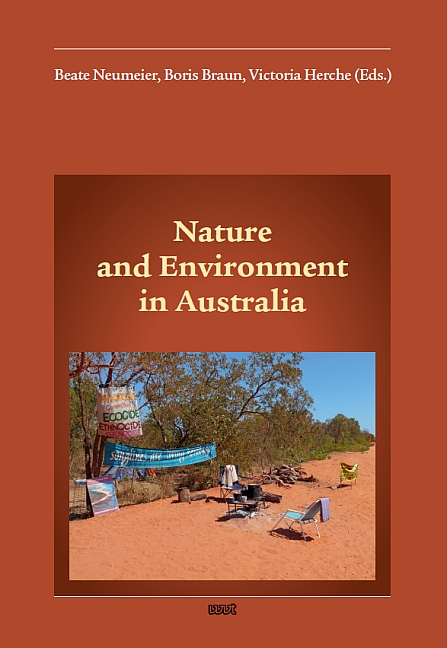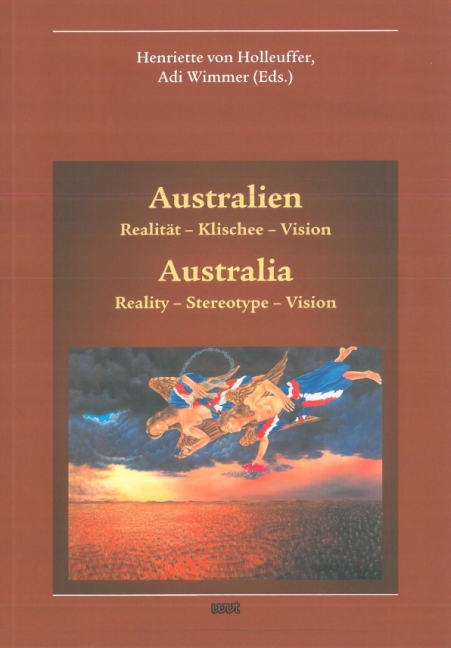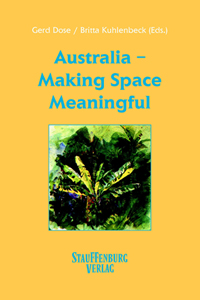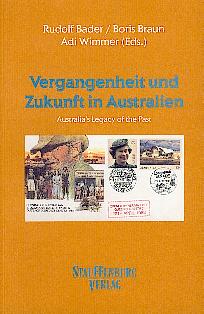Konzepte, Orientierungen, Abhandlungen, Lektüren, Australien-Studien (Concepts, Orientations, Treatises, Readings, Australian Studies)
Edited by Eva Bischoff (Trier), Kylie Crane (Rostock), Barbara Schmidt-Haberkamp (Bonn), Gerhard Stilz (Tübingen) and Boris Braun (Cologne, managing editor).
From 1996 to 2010 published by Stauffenburg, Tübingen. From 2011 onwards published by wvt, Trier.
Click on the cover to be redirected to the publisher’s website.
This volume presents inter- and transdisciplinary perspectives on migration within and to Australia and addresses pressing related social and political issues: histories of (settler-)colonization and the dispossession of Indigenous Australians, asylum and refugee protection, questions of ‘belonging’, human rights, and repercussions for the idea of the nation-state and the promise of multicultural programmes.
The contributions to this volume reflect the transdisciplinary methodologies of migration studies and represent current positions of ethnographic, historical, political, legal, literary, and cultural scholars as well as activists. The concerted efforts of established and emerging scholars provide up-to-date analyses of past and present conditions caused by manifold migrations and contribute to a better understanding of the complexities of migration and how they shape and define the twenty-first century.
This volume presents inter- and transdisciplinary reflections on nature and environment in Australia in different but interrelated contexts at the intersection of the humanities and the social sciences.
The wide scope of the volume includes contributions from anthropological (and ethnographic), historical, geographical (and urbanistic), as well as legal, linguistic, literary and media perspectives, highlighting the productive intersections between these different approaches. The overall goal is to show their inseparability in the concerted efforts to meet the environmental challenges of our time.
Populist rhetoric regarding a “crisis in masculinity” has seen concerns raised about the twinned issues of boys and reading, which has culminated in a call for more “books for boys” in the fields of children’s and young adult literature. Books for Boys examines the ways masculinity is both represented in Australian young adult literature and representative of wider gender discourses. Focusing on texts produced since the 1990s, and adopting a generic approach, Troy Potter shows how genre is implicated in books for boys to respond to and shape public perceptions of masculinity. While some novels may rethink and reconfigure genre and gender, the author demonstrates through close readings that the majority of books for boys reinscribe traditional constructions of both in order to model “appropriate” gendered practices.
This volume presents a collection of ten selected and expanded papers of the 14th Conference of the German Association for Australian Studies (GASt) in Potsdam and Berlin, 2014. They are supplemented by a comprehensive introduction to the complex ways in which the universal notion of justice is continuously renegotiated against the local and cultural particularities of the Australian context. Often – though not exclusively – concerned with the legacy of Australia’s colonial past, the contributions address questions of access and redistribution, obligation and recognition, reparation and restitution, reimagination, reconciliation and forgiveness. The concept of the ‘fair go’, often posited as a key truth of Australian identity, promises a unique take on these issues. Together, the contributions combine historical depth and a breadth of disciplinary backgrounds with an ethical commitment to the possibility of a ‘fair go’ for all.
This volume comprises a collection of ten papers given at the 13th Conference of the German Association for Australian Studies at the University of Stuttgart in September 2012, which are supplemented by a comprehensive introduction to Visual Culture Studies and to Australian Visualities. The contributions probe and critique visual images that have become lodged in cultural memory as powerful vehicles of national identity. Paintings, photographs, mixed media, maps, documentaries, advertisements, cartoons and literary images form the subject matter. Together, the contributions offer historical depth, a breadth of disciplinary backgrounds and draw on Australian and international perspectives. This volume thus makes a timely contribution to Visual Culture Studies and Australian Studies alike.
This volume is a collection of nine papers in English and German given at the 12th Conference of the German Association for Australian Studies at Klagenfurt in October 2010. Its title Realities – Stereotypes – Visions hints at the great variety of topics that were introduced. There are contributions of a general and intensely thought-provoking type, contributions that shed new light on how German or Austrian scientists perceived Australia in the 19th century, and a contribution challenging the vision that Australia can accept further immigration without suffering severe ecological and economic disadvantage. Two papers deal with a specific feature of an Australian film adaptation and the (negative) influence of the Australian popular media. Not surprisingly and continuing a tradition of the series KOALAS, the volume also includes a paper with an entirely new focus on Aboriginal art, more precisely on Christian influences on that art. A final paper offers a discussion of the variegated visions of Australian social utopians of the “Nervous Nineties”. All contributions are intended to stimulate further discussion.
This volume is a collection of ten presentations in both English and German given at the 11th Conference of the Gesellschaft für Australienstudien in Karlsruhe in October 2008. The title, which means “Facets of Australia”, indicates the wide variety of presentation topics, the very variety which make Australia so fascinating. The articles provide insights into aspects of the geography and history of the country, linguistic characteristics of Australian English as well as to Australian literature, pop music and media culture. Of central importance are three articles about the art and the religion of the indigenous population or Aborigines as well as about the emotionally charged topic of the Stolen Generations and its impact on Australian politics even today. The volume can also serve as a guide for teachers who deal with aspects of Australia in various subjects in all types of schools; it includes hints about how to introduce pupils or students to this intriguing continent.
Welche Rolle spielt Australien im Globalisierungsprozess und wie wirkt sich die Globalisierung in Australien selbst aus? Historiker, Kultur- und Politikwissenschaftler, Raumplaner sowie Stadt- und Wirtschaftsgeographen werfen in diesem Band einen jeweils fachspezifischen, aber dennoch interdisziplinär offenen Blick auf den vielgestaltigen Prozess der Globalisierung und fragen nach der Rolle und den Chancen Australiens in diesem grundlegenden, epochalen Wandel. Acht Beiträge von deutschsprachigen und australischen Wissenschaftlern belegen auf vielfältige Weise die zunehmende Einbindung des Fünften Kontinents in weltweite Zusammenhänge. Die Globalisierung birgt für Australien neue Chancen und Möglichkeiten. Australien ist im Laufe seiner Geschichte nicht nur näher an den Rest der Welt herangerückt, sondern unterhält heute auch viel engere Beziehungen zu den umliegenden Ländern Asiens und Ozeaniens. Dies gilt nicht nur wirtschaftlich, sondern zunehmend auch kulturell, gesellschaftlich und politisch. Australien kann damit als ein ‘Gewinner’ der Globalisierung gelten. Aber es zeigt sich auch, dass der Prozess der Globalisierung für den Fünften Kontinent keinesfalls reibungslos, konfliktfrei und ohne innere Verwerfungen verläuft.
Australia: Making Space Meaningful presents a selection of papers dealing with the construction of meaning in relation to Australian space. The papers were originally given during the 9th biennial conference of the Gesellschaft für Australienstudien or Association for Australian Studies (GASt). Approaches to space from a historical, political and literary perspective, questions of the displaced and their spaces, of female appropriation of space, of colonising space, past and present, of differences between German and Australian spaces and the connection between landscape and works of art by black and white artists were given a platform for discussion during this conference.
Elf Beiträge dokumentieren einen interdisziplinären Forschungsertrag, an dem Historiker, Geografen sowie Literatur- und Politikwissenschaftler beteiligt sind. Die Hauptgliederungspunkte des Buches sind: ‘Australiens Außenorientierung: Besinnung auf traditionelle Muster’, ‘Australiens koloniales Experiment in Asien’, ‘Australiens Asienbezug in Wirtschaft und Sprachenpolitik’, ‘Asienkontakte im Spiegel der australischen Literatur’, ‘Der Rückbezug auf Europa in der australischen Literatur’ sowie ‘Australiens Abschied vom Wohlfahrtsstaat: Ein Modell für Europa?’
Historischen Rückgriffe illustrieren, weshalb Australien sich zu Beginn des 21. Jahrhunderts verstärkt am Westen orientiert. Das hier bevorzugte genetisch-evolutionäres Erklärungsmodell bringt einen reicheren Ertrag, als ihn eine bloße Bestandsaufnahme gegenwärtiger Symptome ermöglicht hätte.
Australien beschäftigt sich heute intensiv mit seiner eigenen Vergangenheit. Es zeigt sich dabei, dass die Fiktion eines unschuldigen und glücklichen Kontinents als Leitbild für die Zukunft nicht mehr uneingeschränkt tragfähig ist. Vor diesem Hintergrund greift der Band zentrale Aspekte langfristiger Entwicklungen auf dem Fünften Kontinent auf, die für die Gestaltung der Zukunft wegweisend sein könne. Er umfaßt Beiträge namhafter deutschsprachiger und australischer Autoren aus verschiedenen Wissenschaftsdisziplinen und setzt sich mit zentralen Themenkreisen der australischen Wirklichkeit auseinander. Es geht dabei um literarische Reflexionen von Kolonialismus und Imperialismus, Neuinterpretation australischer Geschichte, oral history der indigenen Bevölkerung, die sogenannten Stolen Generation, die Geschichte der deutschen Einwanderung, Aspekte des gesellschaftlichen und sprachlichen Wandels, ökologische Folgen einer unangepassten Landwirtschaft, die ökonomische Erfolgsgeschichte des Bergbaus sowie Probleme der australischen Urbanisierung und Regionalentwicklung. Der Band leistet einen wichtigen Beitrag zu einer Neubeurteilung der historischen Vermächtnisse in Australien im Hinblick auf ihre belastenden oder positiven Auswirkungen auf die Zukunft.
Die literarischen Reflexionen deutscher Autoren über den exotischen Raum Australien stehen im Mittelpunkt dieser Untersuchung. Dabei bilden die Fragen nach der Funktionalisierung von Fremderfahrung in der Auseinandersetzung mit der fremden Natur und der Kultur der Aborigines sowie der sich etablierenden Kolonialkultur die Leitperspektiven. Das umfangreiche Materialkorpus umfaßt primär fiktionale Texte aus der Zeit vom 17. bis zum 20. Jahrhundert und berücksichtigt Autoren wie Campe, Schoppe, Gerstäcker und von Kotze. Die Untersuchung schließt eine Forschungslücke und bietet sowohl einen Beitrag zur Geschichte des literarischen Exotismus als auch zu soziohistorischen Entwicklungen der deutsch-australischen Beziehungen.
Wo steht Australien heute? An der Schwelle zum 21. Jahrhundert ist es angezeigt, Bilanzen über die Vergangenheit zu ziehen, Standortbestimmungen vorzunehmen sowie Visionen und Utopien über zukünftige Entwicklungen zu entwerfen. Der vorliegende Band hat sich diesen Aufgaben im interdisziplinären Forschungsbereich der Australienstudien gestellt. Er vereint vierzehn Beiträge aus den Disziplinen Anglistik (Sprach- und Literaturwissenschaft), Geographie, Politikwissenschaft, Rechtswissenschaft, Soziologie, Wirtschaftswissenschaft und Bildungsmanagement: Ergebnisse der 6. interdisziplinären Zweijahrestagung der Gesellschaft für Australienstudien e.V.
Ever since the ‘Eureka Stockade’ of 1854 Australia has indulged in periodic outbursts of nationalism. Thus, of Australia’s short history as a European settler society, three quarters are characterized by a variety of nationalist sentiments and practices. But in the 1970s, when Australia officially embraced ‘multiculturalism’, the view emerged that Australian culture had successfully transcended the paradigms of the past. However, the electoral victories of the racist and xenophobic One Nation party in 1996 and 1998 have severely dented such notions. Time therefore to re-assess the values and dangers of nationalist policies and discourses, to examine the boundaries of multiculturality, to evaluate anti-nationalist strategies and to look ahead into the future of nationalist practices in an post-modern age.
Der Band vereint die Beiträge zum Tübinger Australien-Symposium vom 3.–6. Oktober 1996. Er leuchtet am Beispiel Australiens den weltweit verstärkt spürbaren und vielenorts problematisch gewordenen Zusammenhang von materiellen Ressourcen und kulturellem Selbstverständnis aus. Es geht also aus interdisziplinär konvergierenden Perspektiven um das Verhältnis von Geld und kultureller Wertsetzung, und zwar an dem historisch, geographisch und ökonomisch konkret umreißbaren Exempel einer “Neuen Welt”, in der heutzutage die auch in Europa virulenten Entwicklungen nicht mehr in kolonialer Abhängigkeit nachgeahmt, sondern, den USA vergleichbar, schneller und unbekümmerter erprobt und akzeptiert oder auch verworfen werden. Dabei stellen sich unter anderem folgende Fragen: Auf welchen natürlichen Ressourcen gründen Reichtum, Wohlstand und materielle Prosperität in Australien? Inwiefern knüpfen die heutige wirtschaftliche Entwicklung, die gesellschaftlichen Werte und die kulturellen Ziele in Australien an die Zeiten an, da der Fünfte Kontinent die Goldgrube des Empire und die Prägestätte der Guinea waren? Wie wurden und werden diese Verhältnisse reflektiert und mitgestaltet in Literatur und Kunst?














